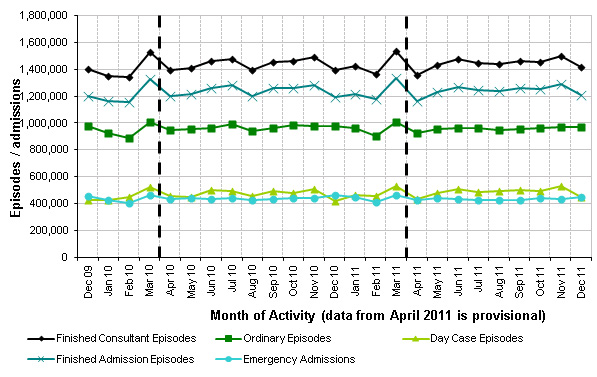IN THIS SITE...

Provisional Monthly HES data for Admitted Patient Care
This is the most recent publication of provisional1 monthly HES (Hospital Episode Statistics) data for NHS Hospitals in England and activity performed in the Independent sector in England commissioned by English NHS. Further details about the publication of monthly HES are in the 'About monthly HES data' document which can be found under related documents.
Key facts
In the year from January 2011 to December 2011 there were:
- 17.3 million finished consultant episodes (FCEs)2, 59.3% (10.3 million) of which included at least one procedure or intervention, and 5.8 million of which were day cases.
- 14.9 million finished admission episodes (FAEs)3, of which 5.2 million were emergency admissions.
Inpatient Monthly Activity by episode / admission type
 |
| Rolling 12 month period comparison | |||
|---|---|---|---|
| Jan 10 to Dec 10 | Jan 11 to Dec 11 | % change | |
| Total Finished Consultant Episodes2 | 17,168,402 | 17,299,599 | 0.8% |
| % FCEs with a procedure4 | 58.4% | 59.3% | - |
| Ordinary; Episodes5 | 11,529,074 | 11,482,193 | -0.4% |
| Day; Case Episodes6 | 5,639,328 | 5,817,406 | 3.2% |
| Finished Admission Episodes 3 | 14,812,623 | 14,887,562 | 0.5% |
| Emergency; Admissions7 | 5,252,736 | 5,227,574 | -0.5% |
| Year to date comparison | |||
|---|---|---|---|
| Apr 10 to Dec 10 | Apr 11 to Dec 11 | % change | |
| Total Finished Consultant Episodes2 | 12,946,939 | 12,976,656 | 0.2% |
| % FCEs with a procedure4 | 58.5% | 59.5% | - |
| Ordinary; Episodes5 | 8,707,401 | 8,611,418 | -1.1% |
| Day; Case Episodes6 | 4,239,538 | 4,365,238 | 3.0% |
| Finished Admission Episodes3 | 11,167,326 | 11,164,044 | 0.0% |
| Emergency; Admissions7 | 3,959,179 | 3,899,721 | -1.5% |
Footnotes
1. Provisional data: The data is provisional and may be incomplete or contain errors for which no adjustments have yet been made. Counts produced from provisional data are likely to be lower than those generated for the same period in the final dataset. This shortfall will be most pronounced in the final month of the latest period, e.g. November from the (month 9) April to November extract. It is also probable that clinical data are not complete, which may in particular affect the last two months of any given period. There may also be errors due to coding inconsistencies that have not yet been investigated and corrected.
2. Finished consultant episode (FCE): A finished consultant episode (FCE) is a continuous period of admitted patient care under one consultant within one healthcare provider. FCEs are counted against the year in which they end. Figures do not represent the number of different patients, as a person may have more than one episode of care within the same stay in hospital or in different stays in the same year.
3. Finished admission episodes (FAE): A finished admission episode (FAE) is the first period of inpatient care under one consultant within one healthcare provider. FAEs are counted against the year in which the admission episode finishes. Admissions do not represent the number of inpatients, as a person may have more than one admission within the year.
4. FCEs with a procedure (or intervention): These figures represent the number of episodes where the procedure (or intervention) was recorded in the main operative procedure field in a Hospital Episode Statistics (HES) record. Please note that more procedures are carried out than the number of episodes with a main procedure. FCEs with an intervention or procedure include: 2009-10 OPCS 4.5 codes A01-O10 & O15-X97
5. Ordinary admission episode: Ordinary admissions are inpatients who have been admitted for treatment. The intention is for treatment to be concluded in longer than one day. If, unexpectedly, the patient is not kept overnight, the episode remains as an ordinary admission.
6. Day case episode: Day cases are inpatients who have been admitted for treatment just for the day. There are therefore always single episode spells with a duration of zero days. The intention is for treatment to be concluded in one day. If, unexpectedly, the patient is kept overnight, it must be re-classed as an ordinary admission.
7. Emergency admissions: The count of admission episodes with an admission method indicating the admission was an emergency(admission method codes: 21 = Emergency: via Accident and Emergency (A&E;) services, including the casualty department of the provider, 22 = Emergency: via General Practitioner (GP),23 = Emergency: via Bed Bureau, including the Central Bureau,24 = Emergency: via consultant outpatient clinic,28 = Emergency: other means, including patients who arrive via the A&E; department of another healthcare provider).
Data quality: Hospital Episode Statistics (HES) are compiled from data sent by more than 300 NHS trusts and primary care trusts (PCTs) in England and from some independent sector organisations for activity commissioned by the English NHS. The NHS Information Centre for health and social care liaises closely with these organisations to encourage submission of complete and valid data and seeks to minimise inaccuracies. While this brings about improvement over time, some shortcomings remain.
Assessing growth through time: HES figures are available from 1989-90 onwards. Changes to the figures over time need to be interpreted in the context of improvements in data quality and coverage (particularly in earlier years), improvements in coverage of independent sector activity (particularly from 2006-07) and changes in NHS practice. For example, apparent reductions in activity may be due to a number of procedures which may now be undertaken in outpatient settings and so no longer include in admitted patient HES data.
Activity included: Activity in English NHS Hospitals and English NHS commissioned activity in the independent sector.
Source statement: Source: Hospital Episode Statistics (HES), The Health and Social Care Information Centre.
Responsible statistician
The responsible statistician for this publication is Chris Dew, HES/SUS Analysis (Service) Section Head ([email protected], 0845 300 6016).
Copyright statement
The copyright to the information we are disclosing is held by the Health and Social Care Information Centre. The HSCIC has suspended the application of re-use licence fees as a consequence of government policy ('Making Public Data Public'), so you may re-use this information free of charge. Please ensure that the following copyright statement is included within your documents: 'Copyright � 2012 Re-used with the permission of the Health and Social Care Information Centre. All rights reserved.' Please also use the citation logo available for download from the HSCIC's website.

